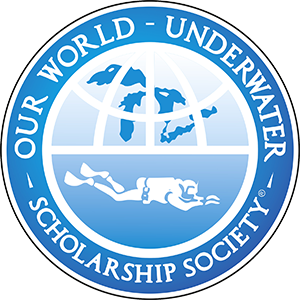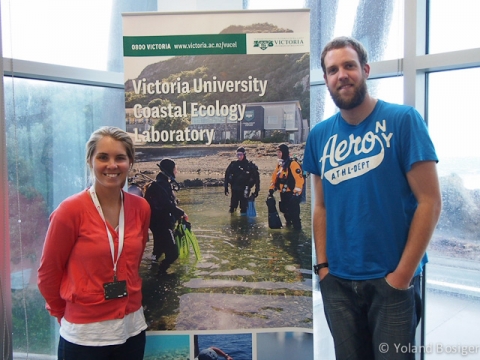Extreme sports, kiwi fruit candy, Marmite, Arataka honey, great coffee, lamb roasts, and not to mention amazing marine life – where else would one find such incredible delights but in New Zealand!
I had arrived in Wellington to visit William Arlidge, Australasian scholar in 2010 for a week before heading off to see Pete Mesley in Auckland. Will picked my up from the airport and we then headed into the Aro Valley where Will, his girlfriend Hannah, and his two flatmates Matthew and Lucy had recently moved into an awesome eccentric little cottage (or flat as the New Zealanders would like to call it). This cute little house had literally every wall painted a different colour from bright pink to green, yellow, red, blue. I get the impression that the previous owners must have gotten really fed up with living in in a whitewash apartment and just gone all out colour crazy when they purchased this place.
That afternoon Will offered to take me for a dive at the Taputeranga Marine Reserve. Firstly I have to emphasize that Wellington in winter gets relatively cold with the water temperature reaching around 14 degrees during July. It can also be quite windy causing the visibility to be reduced. Maybe not so surprising then was the reaction of the dive shop attendant when we rocked up to hire some tanks. “Your going for a dive…” “Why?” “Are you sure you want to go for a dive???” But despite these disconcerting remarks and the fact that I only had a 7 ml Waterproof wetsuit with me, we were going. Plus I had to prove to Pete Mesley that a North Queenslander could dive in New Zealand without a dry suit so off we went. And luckily we did because the diving was awesome! Once we got down a couple of metres out of the wash the visibility was fantastic, some of the best that Will had seen. There was also an abundance of marine life from kelp forests to blue cod, blue moki, banded wrasse and variable triplefin. These fish were also extremely tame compared to anything I had previously experienced. One blue cod swam right up to me and just sat there as if to say, “this is my rock and don’t you even think about stealing it.” A dream come true for an amateur underwater photographer.
We dried off and surprisingly I wasn’t that cold. My Waterproof 7ml really is awesome hey. It is such a fabulous suit and I am so incredibly grateful that Waterproof kindly sponsors the scholarship. That night I was treated to some of the most amazing vegetarian pasties cooked by Hannah and Lucy and then stayed up for a bit sharing scholarship stories with Will. I still don’t think I have really got my head around the full significances and enormity of the opportunities I have been given.
Will is currently working as Science Officer at the Ministry of Fisheries, which entails helping with the regulation and monitoring of New Zealand’s fisheries. A job he insists is fantastic for an “experience” year with more adventures on the horizon in 2013/2014 (Sorry Will, I have to show the guys a picture of you in your office – one day I will make it up to you). Will had suggested that I come along and attend some of the meetings that were being held by the Ministry of Fisheries about Hector’s and Maui’s dolphin and threatened New Zealand seabirds on Tuesday and I was stoked to attend. Seeing how marine science translates into policy and management is one area I really wanted to learn more about this year so this was a fantastic opportunity.
Maui’s and Hector’s dolphins are endemic to New Zealand and are among the smallest cetaceans in the world. Unfortunately both the Hector’s and Maui’s dolphins are endangered and the Maui’s dolphins in particular are the rarest marine cetacean in the world with the entire population estimated to less than 70 individuals. Trawl and net fishing represents the greatest danger to both the Hector’s and Maui’s dolphins and it is estimated that 110 to 150 dolphins die in commercial set nets each year. For more information see: http://www.wwf.org.nz/what_we_do/species/hector_s_and_maui_s_dolphin/. The meeting began with talks and discussions about a large scale aerial survey project which will aim to improve our understanding of the abundance and distribution of the Maui’s and Hector’s dolphins. We then got to listen to Finlay Thompson discuss marine mammel bycatch in New Zealand trawl fisheries and Ed Abraham discuss the capture of seabirds in NZ fisheries. One slightly disturbing trend was the steady decrease in observer coverage recorded in many of the most important fisheries bringing the quality of bird catch statistics into dispute. Hopefully more incentive can be provided for people to become marine observers in future.
On Wednesday, Will took me to visit the Victoria University Coastal Ecology Lab which overlooks the Taputeranga Marine Reserve. I met dive officer, Daniel McCaughton who gave me a tour of the facilities including the wet and dry lab facilities, and student lab area. David then introduced me to Paul Mensink (PhD student supervised by Jeffrey Shima), who is studying the effects of early life history traits on reproductive success as well as the impact of adult size on early life history traits.
An important component of Paul’s work is to age common triplefin fishes using oteliths (calcium carbonate structures located directly behind the brain of bony fish). By counting the opaque zones called annuli on the sectioned otelith ( just as one would count rings on a tree), biologists can fairly accurately determine the fishes age. One fairly obvious pitfall is that fish need to be euthanized prior to analysis so researchers have also proposed that scales could be used to age fish. My job for the day was to identify and isolate usable scales and then using a dissection microscope, select scale with regular bands moving outwards from a small focus (circular shape at the apex of the scale). I had a great time with Paul that day and wish him all the best with the rest of his PhD work.
- Establishing Marine Protected Areas
- Promoting Sustainable Fisheries
- Legal protection for Hector’s & Maui’s dolphins
- Working with fishers to save our seabirds
- Protecting Antarctica and the Southern Ocean
Milena also took me through her day to day work and gave me some fantastic tips about working for international environmental Non Government Organisations. I really loved visiting the WWF and think it is somewhere that I could definitely see myself working in the long run. Thanks a lot Milena.
I then got to spend the rest of the day visiting Gareth Hughes at the New Zealand Greens party. Meeting Gareth was really awesome. He is the youngest person to be in New Zealand parliament and is an active spokesperson for marine conservation and sustainable fisheries. Gareth was kind enough to fill me in on the issues affecting New Zealand’s marine environment including deep water oil drilling and shark finning. I have to say I was very inspired by what Gareth is doing. He really is one of the champions of the marine environment, working everyday to change peoples attitudes about the ocean and make a difference. Thanks heaps to Matthew Gleeson for helping me to set up this meeting.
That evening Will, Hannah and I went out for Mexican and I don’t really know how it happened but I ended up ordering chilli chocolate vegetarian enchilada’s. For those who haven’t had the delightful experience of chilli chocolate Mexican quisine do not hold off any longer! It is amazing.
Thanks so much to Will, Hannah, Lucy, and Matt for having me at their humble abode for a week and showing me around. I had such a lovely time and thanks heaps to Rolex – this funny picture is definitely dedicated to you.











Hi Yoland—-GREAT that you had a fantastic time in Wellington.
They are ok those people who can put up with its weather!!!
Naturally the really good guys & girls live in Auckland!!!! 🙂 🙂
Thanks for calling in when in the “sunny” city.
I and the team wish you an amazing year of adventures and learning.
I hope we meet up again in Vegas in November at the OWUSS gathering.
Take care and safe travels.
Regards.
Dave.